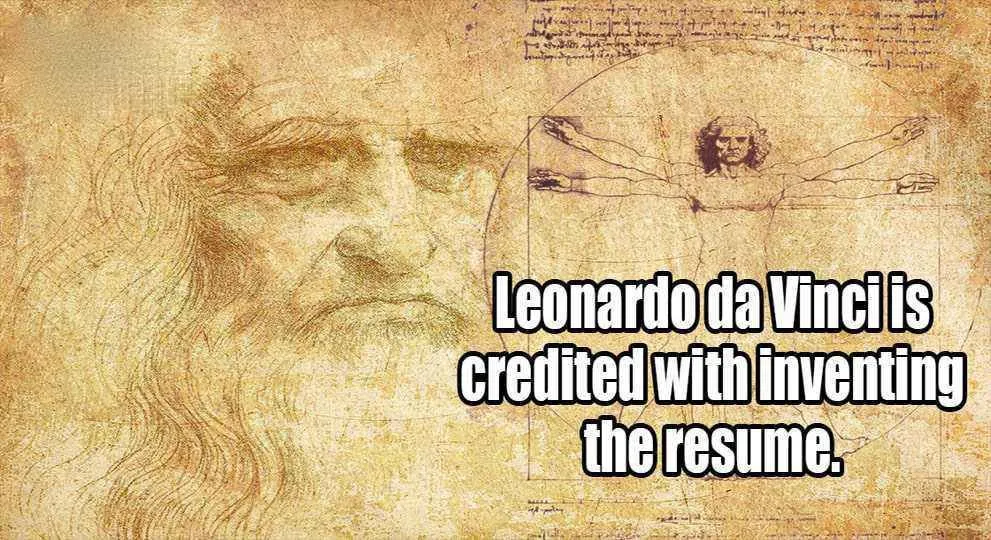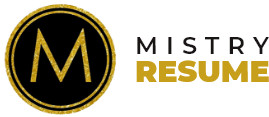

The great Renaissance man Leonardo da Vinci created the first known résumé in 1482. In a written submission to the Duke of Milan, da Vinci cited a numbered list of his qualifications, including his innovative wartime skills in creating new kinds of bridges, mortars, chariots, catapults, heavy artillery and more. In times of peace, he claimed, he could make fine artistic sculptures and paintings. The translation is quite fascinating to read in its entirety.
1500’s

The first time the phrase “résumé” was used is thought to have come from a Lord in England. In his travels, he would submit a letter of professional introduction, which he called a résumé, whenever he entered a new town.
By the end of the century, a documented list of résumés began to appear in local publications, especially in newspapers and handbills. One of the earliest of these ads historians have found was from a man named Ralph Agas, who advertised his 40 years of experience as a land surveyor. He distinguished himself by listing specific experiences and projects he had completed. While the word “résumé” was still not in wide use, the concept was definitely growing in popularity through the 16th century.
1600’s – 1920’s

For hundreds of years, the evolution of the résumé was stagnant. There is little record of these self-advertising professional documents. Part of this is attributable to the lack of need for a résumé; many people were limited to the jobs available to their class or were handed down a profession from the generation before. Another complicating factor was the increase in technology that eliminated some of the need for highly skilled labourers.
1930’s

This period marked the comeback of the résumé. It is said that many were scrawled as handwritten notes during interviews. Soon enough, job seekers realized it would be easier to come prepared. However, there was a stigma about written résumés coming off too arrogant, so their usage was still not widespread.
1940’s

By the 1940s, résumés were aimed at introducing potential employers to the “whole person.” They were somewhat informal introductions that included information that would never fly today due to the risk of discrimination lawsuits. Job hunters were encouraged to list their age, height and weight, and even to include a photograph if possible. The other surprising elements of a 1940s résumé included listing marital status—even the number of kids—and a religious or church affiliation. Professional history was also included, but overall the résumé was balanced between personal and professional.
1950’s

Résumés became an expectation in the 50’s. Many employers would request them to be submitted with the job application. Many job seekers began distributing résumés at any and all businesses in town as part of a strategy to “hit the pavement.”
1960’s

The 1960’s began an era of individualizing oneself on the job market. The latest trend was to include hobbies and extracurricular activities.
1970’s

Digital typesetting and word processors made it faster and easier to make more professional-looking résumés. The newest trend was to more aggressively market oneself on a résumé, a startling change from the more humble origins of the 1940s. Personalization, like listing sports and club activity, fell out of trend.
1980

Innovative job seekers in the 80’s recorded themselves introducing their work history using VHS videotape. This cutting-edge approach was a bit too ahead of its time and quickly went out of style only for video résumés to rise again nearly 30 years with the advent of YouTube.
1984

With the release of the book How to Write Your CV, professional self-help career books became a hot genre. The market was flooded with often-conflicting advice on how to best market oneself to employers.
1985

1985 – Online background checking began much earlier than many job candidates realize. 1985 brought the ability to research potential candidates using an online database. Over the following years, more companies would gain access to these databases that would contain a growing wealth of information on criminal history, education credentials and even credit.
Mid-80’s

The mid-80’s was also the beginning of a huge debate, with some people claiming the resume was going out of style. The thought was that a résumé was old-fashioned, though few were very clear about what they expected to replace the now ubiquitous document. After all, the one-page professional history was hard to beat in terms of efficiency. Still, many believed résumés were on the out.
1986

Microsoft released its document format known as RTF. These “rich text format” files are still popular or résumés in 2016 because they pass most parser software with little information loss.
1987

This year brought one of the biggest crazes in job seeking—the fax machine. Those looking to stand out skipped snail mail and even the personable hand-delivery methods in favor of the fancier ability to fax.
1994

predecessor to Monster.com was launched in 1994, just three years after the internet went public. Founder Jeff Taylor originally set up the job database to use listings from his own HR company’s newspaper division. Two years later, “The Monster Board” took off after an onslaught of media attention. Monster was officially the first online job search and the first online public résumé database.
1995

By the mid 1990s, direct email became the most popular way to submit résumés.
1996

This year brought the free use of Adobe’s PDF, a new format that trended among job seekers. PDFs would begin to fall out of favor in later years as some companies began using “Applicant Tracking Software” that had difficulty parsing PDF into a readable format.
2000’s

The turn of the century brought one of the more innovative evolutions: interactive résumés. What these entailed varied, but with it being increasingly easy to create personal websites, many turned to starting their own multi-page sites complete with widgets and pictures. Graphic designers were beginning the trend of infographics and other more visual forms of résumés.
The 2000’s trends were very big on cover letters and objectives. Cover letters were indicated as a way to introduce oneself to a hiring manager and were typically one page long. They allowed an insight into the candidate’s personality and, sometimes, their personal history. The “Objective” was placed at the top of a résumé itself and told the reader what the candidate hoped to accomplish, usually by listing the specific position applied for and their desired career trajectory. By the end of the decade, many recruiters would admit to not reading cover letters or objectives at all, but many job seekers still submit a cover letter to, well, cover their bases.
2003

One of the biggest game-changers in the entire history of résumés was LinkedIn, founded in 2003. Similar to Monster, LinkedIn allowed a static place to publicly list one’s résumé. However, LinkedIn took it several steps further by creating a well-rounded, professional networking site that went above and beyond mere job postings. LinkedIn encouraged continuous interaction among all of the professional “Connections” a person had accumulated over the course of their entire career. It was essentially the first successful professional social media site.
2005

By mid-decade, companies were struggling to handle the number of incoming résumés. Applicant Tracking Systems became increasingly popular. ATS software allowed employers to receive applications and keep tabs on a created profile all the way through hire and beyond.
The downside of ATS hit job seekers hard. Their uploaded résumés were first converted into a more computer-friendly format, meaning fancy header images, funky spacing, bullet points and other formatting issues clogged up the system. The jumbled mess, when forwarded to the hiring manager, was often unreadable or, perhaps worse, missing key information. This is why RTF files still remain so popular.
Of course, this was assuming a person’s résumé was ever seen by human eyes anyway. ATS allowed companies to auto-filter incoming résumés, deleting any that did not display particular attributes like a college degree or specific keywords and skills. Most companies admitted that this was not a foolproof method. Indeed, the computer did boot some excellent candidates when their résumé lacked an important word or two.
Getting too creative was also a risk for job seekers, as only the most traditional phrases were understood by the computer—not, for example, the quirky “Marketing Ninja” type job titles. However, it was overall a risk hiring companies felt necessary to take, especially after the downturn in the economy led to a disproportionate number of applicants for each position. ATS made the thousands of résumés more manageable to sort through. In turn, candidates had to downplay their personality in order to pass the computer software.
2007

With the launch of YouTube, the 1980s “video résumé” was back in full force. Interestingly, many of the first submissions were from high school students applying to colleges. These videos took off in the professional world over the next year and, while they certainly haven’t replaced the traditional résumé, they are often found on LinkedIn profiles as a more personable introduction.
Around this time, online portfolios also increased in popularity. “Personal-professional” websites became a place where a candidate could list far more information than could fit into a one-page résumé, including examples of their work and a full-fledged blog.
2008

With the loss in favor of the “Objective” section and the daunting rounds of ATS sorting, candidates were searching for a new way to add some personalization to their résumé. Soon came the trend of the professional headline, a short sentence that used keywords to encapsulate what made a candidate unique and/or what their values were.
This was part of an overall shift toward “personal branding,” a more conscious use of keywords in a person’s online professional appearance. Job seekers became more aware of employers Googling them; with this came more effort both to clean up their online reputation and to use targeted SEO to boost their professional image.
2009

Toward the end of this decade, résumé writing services were the largest they’d ever been, totaling approximately 4,000 to 6,000 résumé writers in the U.S. Free resume templates make it easier then ever to create resumes.
This year also saw the founding of the web company Prezi, which sought to revolutionize the traditional PowerPoint presentation. More innovative users were quick to recognize the potential to create a “Prezumé” that truly upped the game on interactive résumés. Some users reported feedback where recruiters admitted they’d spent 10 to 15 minutes enjoying the experience of clicking around the information. By 2013, Prezi launched 3 templates specifically dedicated to creating an interactive résumé.
2010

The new decade brought a keener interest in multimedia and social media working together to increase the effectiveness of the more traditional résumé. Job seekers began including personal-professional links, even QR codes, on their résumé and on LinkedIn. Infographics began to trend among those outside the graphic design industry.
2012

By 2012, the number of large companies using ATS software to sort résumés was in the high 90% range. Nearly every Fortune 500 company used one, and the software continued to kick out up to half of all incoming applications based on the parsing of specific keywords. Many ATS programs now assigned a ranking, letting hiring managers and recruiters immediately start from the “top of the pile,” so to speak. All of the technology made it even harder to get noticed when applying for a job.
Thus, industry insiders admitted that a job seeker’s best chance of landing an interview and getting hired was through personal referral and networking rather than by simply submitting a résumé. Websites like LinkedIn made this type of relationship-based approach much easier.
2013

Microsoft published an interesting study in May 2013. The findings indicated our attention spans have shrunk by a full 4 seconds, from 12 seconds in 2000 to just eight seconds in 2013. The latest trend in résumé writing was coinciding with this realization, with shorter, more “tweet-like” phrases taking the place of longer paragraphs.
This also brought a more streamlined, result-oriented way of presenting work experience. Previous years had seen the bullet point approach listing job responsibilities and some accomplishments. The newest formula of 2013 was “Problem à Solution à Result.” The goal was to show how a candidate could bring results to the bottom line of a company by demonstrating—with examples—an ability to recognize a problem, brainstorm a solution, and then effectively follow through.
This year also began to relive the same debate from the mid-1980s, whether the résumé was dying, already dead or just simply evolving. The general consensus was the need to show rather than tell. The traditional résumé was quickly becoming “boring” and never told the whole story. Instead, using online, multimedia portfolios, either with a personal website or LinkedIn, was seen as the true future of the résumé.
Still, some recruiters felt these sites were too restrictive. A candidate could always paint himself or herself in the best light. Googling and researching job seekers was still the best way for recruiters to get the full picture.
2014

A few LinkedIn rivals launched in 2014, including Apploi, which aimed to make applying for jobs from mobile easier than ever before. Another company, GroupTalent, claimed it could match jobs with applicants using an “e-Harmony-like algorithm.”
2015

Following on the heels of the great 2013 debate, buzz about the “bio” began to heat up. The bio was a way to paint a more full picture of a candidate than a traditional résumé. Many began referring to a “relationship economy;” a recognition that the new job market was less about having all the right skills and more about one’s fit within the company culture.
At the same time, another study was proving this relationship approach to be more valuable than relying strictly on facts from a candidate’s résumé because, perhaps unsurprisingly, many people were lying about the realities of their work history.
The Society of Human Resource Managers reported 53% of résumés and job applications contained “falsifications,” while an astounding 78% contained information categorized as “misleading.” These findings included listing fake degrees or certifications, incorrect employment dates, inflated job descriptions and even falsified references.
A full 70% of college students admitted they would lie on a résumé to get a job, making recruiters more suspicious of résumés than ever before.
2016 & Beyond

While it can be difficult to keep on top of the trends, the best news in today’s job market is the wide variety of options available. Job seekers can submit RTF résumés to ATS’s; build up their LinkedIn profiles for effective networking; launch their own professional websites complete with a blog; market themselves through various social media like Twitter and Facebook; print QR codes on their business cards and more. All of these approaches have become extensions of the résumé itself. To rely only on a résumé in 2016 is seen as utter foolishness.
Luckily, with so many avenues to self-advertise beyond the simple résumé, job candidates have a better chance than ever of not only finding a job but also finding one that is a good personal fit.


